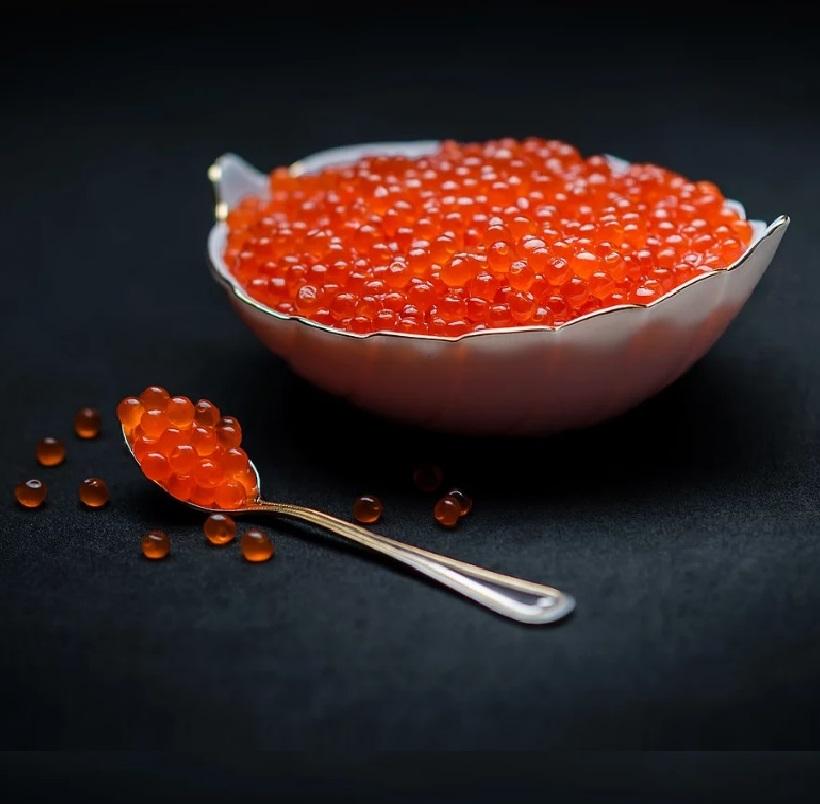Fish Roe & Caviar: Types, Benefits, and How to Choose This Delicacy
Once reserved for special occasions, fish roe and caviar now show up far more often at our tables—on delicate canapés, in light salads, on festive platters, in sushi, and in refined tasting menus. Beyond their subtle flavor and distinctive texture, these tiny pearls hide real nutritional value: they’re rich in protein, omega-3 fats, and essential vitamins.
Freshwater fish roe is known for its fine, balanced taste, while salmon roe and black sturgeon caviar stand out with a fuller, more complex flavor that turns any meal into a celebration. Below, you’ll find the main types of caviar, how to choose what suits you best, and simple, stylish serving ideas to bring out their elegance.
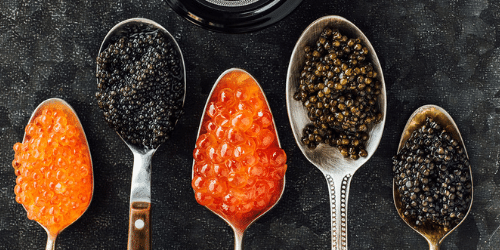
The story of caviar begins on the shores of the Caspian Sea, where for centuries Persian and Russian courts turned the black eggs of beluga, osetra, and sevruga sturgeons into a culinary ritual.
As its fame grew, so did pressure on nature: overfishing and poaching pushed these species toward extinction, and in 1998 the international trade was strictly regulated under CITES. Since then the caviar world has changed. Increasingly, supply comes from specialized farms, where responsible aquaculture ensures traceability, consistent quality, and—most importantly—protection of wild populations. The shift from “what the sea brings” to “what the farm cultivates” hasn’t dimmed caviar’s allure; it has given it a new lease on life: ethical, sustainable, and predictable.

With this transformation, the myth that only aristocrats can afford caviar has also faded. Serious farms have stabilized the market and broadened the price ladder. Siberian (baerii), white sturgeon, or sevruga selections can be excellent without being exorbitant. Many houses now offer 30 g tasting tins—a perfect invitation for anyone curious to explore textures and flavors without a big outlay. Today, Siberian (baerii) or osetra caviar can often be found around $50–$100, depending on species, grade, and origin. Explore the roe selection in magazinul online Berezka”s online shop – responsibly farmed, traceable quality at prices for any occasion.
Next, we’ll look at the three big families—black, red, and “white” roe—to understand differences in taxonomy, species, texture, and flavor, then cover how to choose and store them, their nutrition, and a few serving suggestions.
They’re all roe… so where does ‘caviar’ come in? In Romanian, „icre” (roe) is the umbrella term for fish eggs; „caviar” in the strict sense refers to salted sturgeon roe (family Acipenseridae)—which is also how the Codex Alimentarius defines the international product standard. In everyday speech and commerce, however, phrases like “red caviar” for salmon roe (ikura) are common, which explains why searches contain “red caviar / black caviar.” Regulations try to keep labels clear: in the U.S., unqualified “caviar” is reserved for sturgeon; other products must name the species (“salmon caviar,” “whitefish caviar,” etc.). In the EU, beyond general consumer-information rules, caviar lots are tracked by CITES codes (species, source, country, year) to ensure traceability and legal origin; the Aquaculture Advisory Council has urged clearer labeling to avoid confusion. International additive databases likewise note that “caviar” refers to sturgeon roe, while similar products from other species are caviar substitutes.
With that clarified—why we say red roe rather than red caviar—let’s move to black sturgeon caviar.
Black caviar — for special occasions
Black caviar—obtained from the sturgeon family—has been a delicacy for centuries. It appears in Greek writings as early as the 3rd century BCE and has remained a symbol of refinement ever since. Species include beluga, sevruga, osetra (nisetru) and, more rarely, sterlet. Because of overfishing, wild sturgeon are now protected; today most caviar comes from aquaculture. (In Russia, catching wild sturgeon is prohibited by law.)
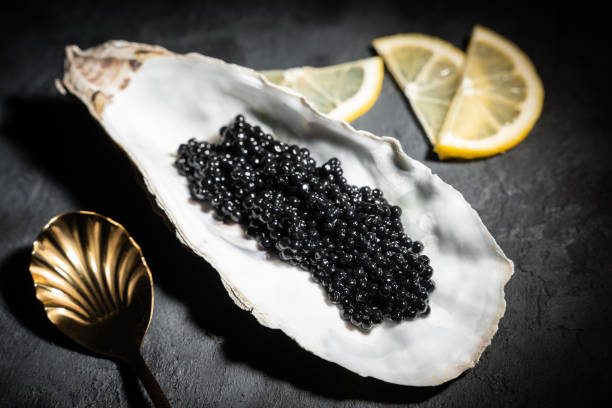
The taste of black caviar is unique—delicate yet gently briny, hard to compare with anything else. The eggs have elastic, fine-grained texture that pops pleasantly on the palate. Its elegant look—small, glossy pearls with subtle highlights—completes the aura of luxury.
Another key detail is how it’s prepared: sturgeon caviar is fully matured and not pasteurized, preserved only with salt. This simple method keeps aroma and freshness intact. By contrast, unsufficiently matured river-fish roe, often harvested illegally, typically requires preservatives and never reaches the same quality. That’s why authentic black caviar remains not just food, but a symbol of festive tables and refined living.
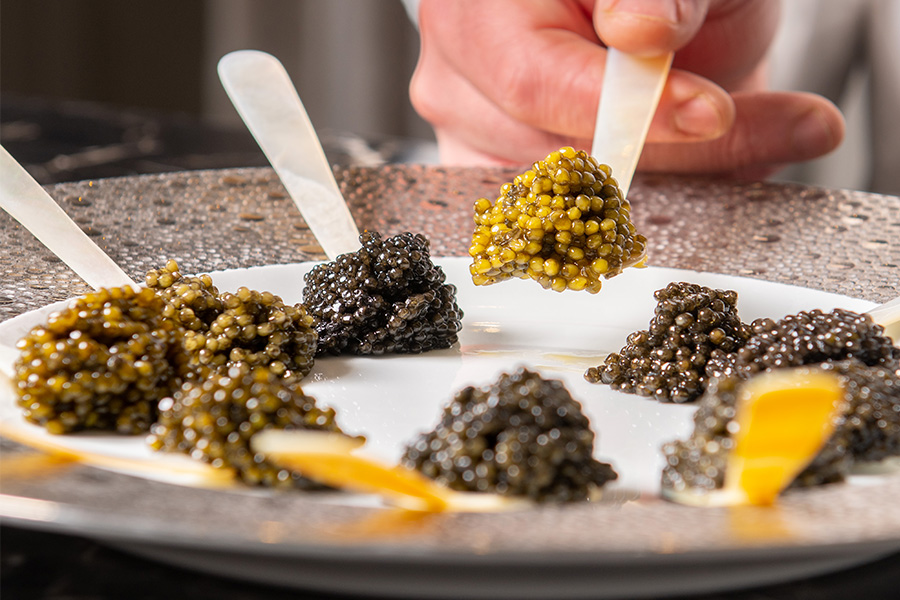
Black caviar spans several varieties, each with its own story, taste, and finesse:
- Beluga / Morun (Huso huso) – The most prized and expensive; largest eggs among sturgeons. Silky, creamy texture with a delicate, refined taste and no iodine harshness. Semi-translucent grains ranging from deep black to pale gray—the lighter the color, the softer and more refined it tends to be. The benchmark of gastronomic luxury.
- Nisetru / Osetra (Acipenser gueldenstaedtii) – Also known as “Russian sturgeon.” Medium eggs (up to ~2.5 mm) in hues from brown-gold to amber. Balanced flavor with subtle nutty notes and a firmly set texture—versatile and popular. Premium, yet more accessible than beluga. (We offer excellent deals up to la 500 g on sturgeon black caviar (nisetru)!
- Sevruga / Pastruga (Acipenser stellatus) – Small eggs (~1.5 mm) from light to dark gray. Intense aroma with a long finish. Considered the more accessible of the classic sturgeon caviars, yet rich in nutritious fats, giving a taste reminiscent of beluga.
- Sterlet (Acipenser ruthenus) – Small-to-medium gray eggs with a clearly marine-saline taste and slightly firmer texture than sevruga. Appreciated for its clean profile and moderate price; historically frequent at Russian royal tables.
- Kaluga (Huso dauricus) – Rare and extremely precious, with large eggs and a delicate taste akin to beluga, though a bit less intense. Pricier due to rarity; Kaluga is protected (Russia’s Red Book) and slow to recover from past overfishing. In our colection we have: Amur Royal black caviar, from the natural Amur × Kaluga hybrid.
- Ship/ Fringebarbel sturgeon (Acipenser nudiventris) – A lesser-known variety with medium-sized pearls and a distinctly iodine-tinged savor. It’s not as widely seen as the others, yet it remains a connoisseur’s curiosity.
Turn every meal into a refined experience—order premium black caviar from Berezka’s selection.
Red Roe
Red roe, harvested from salmon, is more accessible and more widely available than black sturgeon caviar, yet just as valuable for its flavor, variety, and nutritional benefits. In Russia it is, without question, the most popular “caviar,” and it’s always sold as clean, perfectly formed beads.
Its large-scale consumption began relatively recently—only in the second half of the 19th century—alongside the rise of fisheries in the Far East and the Primorye region, far from Europe’s urban center.
Salmon roe impresses not only with its rich, well-balanced taste but also with remarkable nutritional value. It’s an excellent source of easily absorbed protein, essential amino acids, minerals, vitamins, and folic acid—so important for the body.
Today, red roe is sourced both from wild fish and from certain aquaculture species. Wild-caught remains the most prized, because each salmon species yields eggs with distinct sizes, colors, and aromas—from the large, vividly orange beads of keta to the subtler, more delicate shades of other varieties.
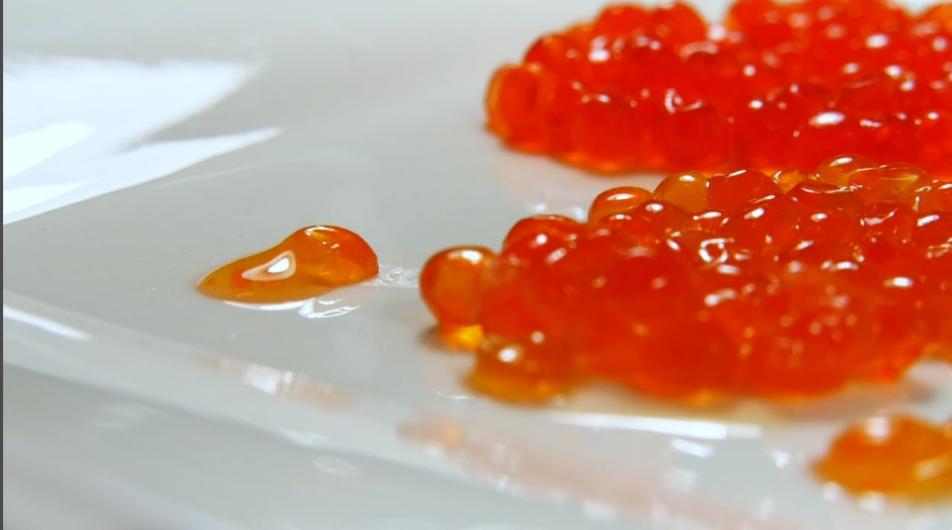
- Icre de somon keta (chum, gorbusha-keta) –The eggs are large (approx. 5–7 mm), light to vivid orange, with a firm texture and a thin membrane that bursts pleasantly on the tongue, giving a juicy pop. The flavor is gentle and balanced—slightly sweet-salty and creamy—with no bitterness and no fishy smell. Considered the benchmark for red caviar, it’s a staple for sushi, canapés, and festive starters. Note: if the grains exceed 4 mm and the shell feels very thick, it’s a sign of over-ripe roe and thus lower quality.
- Icre de păstrăv – Sourced mostly from aquaculture and easy to find. The grains are small (≈ 2 mm), sometimes seeming to “cling” together, in shades from pale orange to deep red or even golden-translucent. The taste is delicate, though it can carry a faint characteristic bitterness. Ideal for canapés, pasta, salads, or sushi, where they add an elegant visual accent and a discreet, crisp texture. For an even more pleasant profile, our range includes Disas salmon-hued trout roe!
- Icre de somon sockeye (nerka) – Small-to-medium grains with a deep orange-red color. The flavor is intense, slightly spicy, distinctly oceanic—a favorite among gourmets who enjoy bolder profiles. Though similar in size to trout roe, it’s more saturated in color and firmer in taste.
- Icre de somon kizhuch (coho) – A deep red hue, a pronounced bitter edge, and rather small grains. Often cited as the healthiest salmon roe, but the taste isn’t universal—aimed more at connoisseurs. A rare, premium product appreciated in gourmet circles.
- Icre de somon roz (gorbusha) –he most widespread wild salmon roe on store shelves. Medium-sized grains, cleanly separated, bright orange, with a familiar, classic taste. If you find pink roe with a diameter over 4 mm, it likely comes from over-ripe fish and quality drops: thicker skins, weaker flavor. We carry a very rich selection of pink salmon roe—see the full offer.
- Icre de somon chavicha (king salmon) – A rare and highly prized type with large, perfectly round grains that do not stick together. Delicate, elegant flavor and an even texture. Thanks to their stately look and impressive size, chinook eggs are ideal for special occasions and luxury platters.
See all red-roe styles available in our shop.
More Affordable Alternatives — “White” Roe
The most popular white caviar for Romanians are:
- Pike roe –A more pronounced, salty profile; perfect for the classic Eastern European roe salad. Emulsified with oil and lemon into a smooth spread for canapés.
- Capelin roe (masago) – Very small eggs from capelin (smelt family), naturally pale yellow and often dyed for sushi. Salty, lightly smoky taste and a softer texture than tobiko. In sushi bars, masago is naturally pale but frequently colored orange, green (wasabi), or black; tobiko can also be colored (including with cuttlefish ink for black).
- Cod roe (tarama) – Salted and matured roe (usually cod or carp) used to make Greek taramasalata. The traditional paste is beige, though commercial versions are often dyed pink.
Romania has an ancient culture of white roe or freshwater fish roe – roe salad (carp/pike) is a classic appetizer and even has European recognition: "Traditional carp roe salad" is TSG (Traditional Speciality Guaranteed) in the EU Register, and "Salad with pike roe from Tulcea" has PGI (Protected Geographical Indication), a sign that we are talking about an established and officially validated culinary tradition.
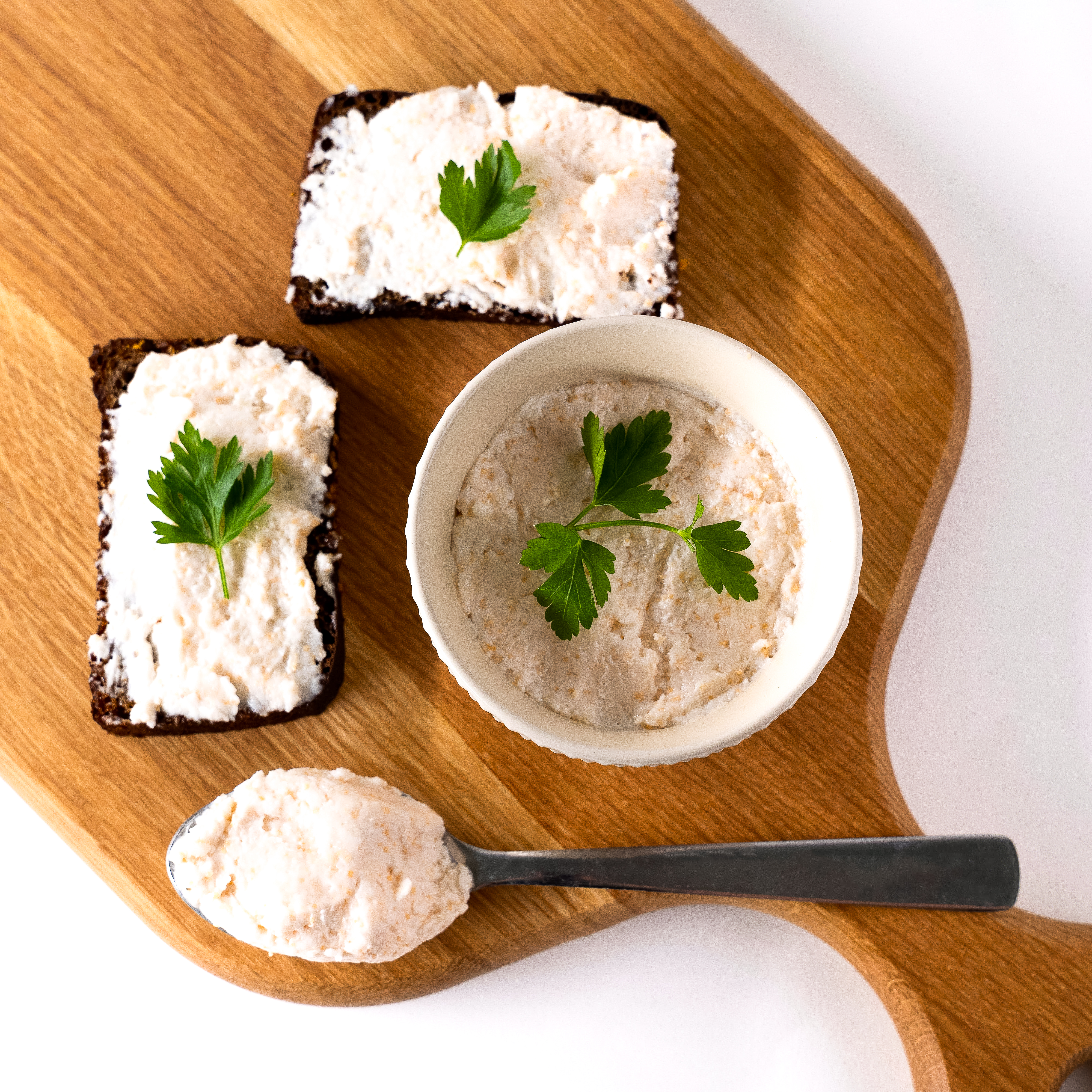
Fish roe salad - Berezka online store
The classic recipe is simple: pike or carp roe mixed with neutral oil, a dash of lemon juice for freshness, sometimes a little mineral water to make it foamy, and finally finely chopped onion for flavor. In many homes, it is "bound" with a little boiled semolina, just enough to stick well to the bread. On canapés, alongside tomatoes, cucumbers, or baked potatoes, "white" roe is the kind of ingredient that quickly solves an appetizer and everyone likes it. That's why they remain a safe choice: they are affordable, versatile, and have exactly that familiar taste you're looking for when you have guests or want something good, without complications. And if you like to experiment, you can alternate between pike (saltier, with personality), cod/tarama (smooth, for creams), or masago for colorful accents in modern dishes. Local tradition actually gives you the confidence to start here and choose the option that best suits your taste—whether classic or modern.
Discover and order authentic white caviar—from pike , cod , carp or capelin – directly from Berezka .
How to you chose the best caviar?
A first important criterion is the type of processing, because it makes the difference in taste, texture, and shelf life.
For example, Malossol roe are the most delicate: lightly salted, with a fine taste and eggs that “pop” nicely when you bite into them. They’re perfect for moments when you want to enjoy their freshness right away, but remember—they don’t keep for long, so it’s best to savor them while they’re still fresh.
By contrast, pasteurized roe goes through a gentle heat treatment. This makes it more durable and safer to transport—ideal if you want to have it on hand for longer. The only difference is that the texture becomes a little firmer, but the flavor stays just as pleasant.
And for those who seek absolute authenticity, there’s the option of raw, refrigerated roe. Unpasteurized and kept only cold, it has the most intense, “alive” aroma. However, because it’s so natural, it requires a flawless cold chain and must be consumed quickly.
A first important criterion is the type of processing, because it makes the difference in taste, texture, and shelf life.
For example, Malossol roe are the most delicate: lightly salted, with a fine taste and eggs that “pop” nicely when you bite into them. They’re perfect for moments when you want to enjoy their freshness right away, but remember—they don’t keep for long, so it’s best to savor them while they’re still fresh.
By contrast, pasteurized roe goes through a gentle heat treatment. This makes it more durable and safer to transport—ideal if you want to have it on hand for longer. The only difference is that the texture becomes a little firmer, but the flavor stays just as pleasant.
And for those who seek absolute authenticity, there’s the option of raw, refrigerated roe. Unpasteurized and kept only cold, it has the most intense, “alive” aroma. However, because it’s so natural, it requires a flawless cold chain and must be consumed quickly.
When you’re in front of the shelf, look at the label to be sure you’ve found what you wanted: the species (sturgeon—beluga, osetra, sevruga, baerii; or salmon keta/sockeye, trout, pike), the processing style (Malossol, pasteurized, raw refrigerated), and the ingredient list—good products are essentially roe, salt, and sometimes an approved preservative.
Also check the appearance: the eggs should be uniform in size and color, with a natural sheen and no excess liquid in the jar. Packaging matters—well-sealed glass or metal, a flat lid (not domed), a clean label, and legible date and lot. If you’re buying online, check that the seller ships chilled (ice packs/insulated box) and delivers quickly; the roe must arrive cold, not “at room temperature.”
Natural caviar or immitation?
Is it “natural,” or just nicely dressed up? Artificial caviar is designed as an analogue of the classic product, but much more affordable and suited to a wider audience. In its earliest forms, which appeared almost a century ago, it was made from gelatin or egg white—solutions that, ingenious at the time, nevertheless strayed from the main goal: to replicate as faithfully as possible the taste and texture of natural roe.
Today, things have changed radically. Nearly 99% of producers worldwide use seaweed extracts to create artificial roe. The key ingredient is agar-agar or sodium alginate, extracted from brown or red algae, which allows for forming beads that, at first glance, can be hard to distinguish from the real thing.
Imitation caviar comes in a surprising variety: red or black, resembling salmon or sturgeon, and versions that mimic pike roe or masago (flying fish). Of course, even when they imitate prestigious species like beluga or sevruga, these products remain consistently more affordable than authentic caviar.
Another advantage is that imitations are very popular among vegetarians and vegans, who seek extra variety and a special taste in their diet without consuming animal products. Thus, artificial caviar is not only an economical alternative but also one that meets modern dietary preferences. In our shop you’ll find red and black imitation roe—an accessible, tasty solution for any meal—discover the offer and order online.
If you doubt that what you’ve bought is truly a natural product, you can do a few quick checks at home.
Open the chilled jar and spoon a tablespoon into a glass bowl — the eggs should remain separate, firm, and round, not burst or stick together into a paste. To the touch they feel elastic, and when you bite down they give that discreet little “pop”; if they’re soft, sticky, or collapse into a gelatinous film, that’s not a good sign. The smell should not be sharp at all; garish colors (neon orange, “absolute” black) often betray dyes — this is normal for products like masago or lumpfish “caviar-style,” but for salmon or trout the shades are usually golden–orange–reddish, not fluorescent.
Another simple clue is taste — the salt should support the flavor, not dominate it; if it strikes you as only salty and nothing else, the quality isn’t great. After opening, keep at 0–4°C and consume quickly (generally 1–3 days for raw; with pasteurized you can go a little longer). Avoid silver when serving (it oxidizes and alters the taste); use stainless steel or mother-of-pearl.
How do you store roe properly?
You’ve bought roe—perfect; here’s what to do to keep its flavor:
Keep it in the refrigerator at all times, in the coldest zone, at 0–4°C, and open the jar only when you need it. Sturgeon caviar should not be frozen (it loses its fine texture), and for salmon red roe freeze only if the label states it clearly. After opening, press a piece of plastic wrap directly onto the surface of the roe to limit contact with air, close the lid tightly, and consume quickly (generally 1–3 days for raw versions, a bit longer for pasteurized). For serving, bring it cold, not frozen; keep the jar on a small bed of ice, not buried in it. And please avoid silver: it oxidizes and alters the taste. Choose stainless steel or mother-of-pearl spoons, clean and dry.
When it’s time to set it out, keep things simple. For a foolproof contrast: potato chips + crème fraîche + a teaspoon of caviar—crisp at the base, creamy in the middle, a salty accent on top. Want something retro-chic? Deviled eggs finished with trout roe—they look great and are one-bite easy. The iconic double-baked potato with caviar (à la Kaspia) remains a delightful little extravagance; for a warm option, crisp smashed potatoes with ikura are photogenic, satisfying, and easy to portion. The classics are just as good: fluffy blini, buttered toast, a lightly sweet brioche, or cucumber rounds with a smooth cream. In general, black caviar loves discreet garnishes (sour cream/crème fraîche, good butter, very finely sliced scallions, chives), whereas red roe excels on warm, starchy bases (potato, rice, pasta) where the color and pop stand out. Small portions are key: 10–15 g/person as an appetizer is enough to deliver the “wow” without overdoing it.
For drinks, choose palate-cleansing options. Dry white wines (Chablis, Muscadet, Albariño, Sauvignon Blanc) or a brut Champagne/classic sparkling are safe bets: their acidity cuts the creaminess and lets the roe’s aroma lead. If you prefer spirits, well-chilled vodka is a classic pairing. For non-alcoholic options, chilled sparkling water with a thin slice of lemon does exactly what it should: refreshes without leaving residual flavor. With these few rules, roe is stored correctly, presented beautifully, and becomes that elegant touch that turns an ordinary meal into a moment to remember.
Is it worth it from the point of view of nutrition?
Yes, in small portions! Roe is a concentrated source of easily absorbed protein and omega-3s (EPA/DHA)—the “good” fats associated with heart health and cognitive function. It also provides fat-soluble vitamins (A, D, E), plus B12, choline, and useful minerals (such as selenium). Its creamy texture doesn’t come only from fats but also from phospholipids—the natural components of cell membranes that give that smooth, “rich” feel on the tongue. If you’re into numbers, a handy benchmark is a 1-tablespoon (~16 g) serving of caviar: about 40–42 kcal, 3.9 g protein, 2.9 g fat, roughly 240 mg sodium, and around 0.46 µg vitamin D (values vary by species and processing). In practice, you get a lot of flavor and nutrients in very little volume, which explains why roe works so well as an accent in a dish, not as the main element.
Obviously, there are nuances. Sodium content can be high in some lots, so small portions are your friend (10–15 g per person as an appetizer is an easy rule of thumb). In pregnancy or for children, choose pasteurized versions, small portions, and watch for allergic reactions. And if you want to compare products easily, convert the price to 10 g, not just jars of different weights—and choose the species according to purpose: large eggs and intense color for plating (keta, sockeye), small-to-medium eggs for spreads and salads (trout, pike), sturgeon caviar for evenings when you’re after finesse and balance.
Curiosities about caviar
- It’s said that mothers who eat roe during pregnancy enrich their diet and support a child’s healthy development.
- In cases of hangover or marked fatigue, roe helps the body recover quickly, being easy to digest and full of nutrients.
- Worldwide, nearly one million tons of red roe are sold annually, which averages roughly 200 g for every person on the planet.
- Industrial harvesting of roe began only a century ago. Before that, any surplus not eaten immediately spoiled quickly and was thrown out with the fish offal.
- Statistics show that, out of ten people who taste roe for the first time, nine come back to buy it.
- For some salmon roes (pink or chum), quality can be checked simply: place a few eggs on a plate and blow gently. If they stick, they’re not good quality; if they roll, they’re excellent.
- Roe shouldn’t be served cold straight from the fridge, but at room temperature, to reveal its full aroma.
- About 30% of roe by weight is high-quality, easily absorbed protein, which makes it ideal for people who are weakened or convalescing.
- Red roe stimulates serotonin production and may even have beneficial effects on libido. A gourmet product with a surprising bonus!
- According to production standards, red roe must be salted within 4 hours of catching the fish, right at the fishing site, to preserve quality.
FAQ Roe & caviar
- Is it allowed during pregnancy?
Yes, if pasteurized and stored correctly at 0–4°C. Avoid raw/unpasteurized roe (higher microbiological risk). Mind the sodium and stick to small portions.
- How do I recognize weak products or “fakes”?
Beware unusually low prices, long ingredient lists (colorants, flavors, stabilizers), and vague labels (no species named). Eggs that are too uniform in size/color and an excessively salty taste are signs of a weak product. For sturgeon caviar, look for the species on the label and a clear lot (traceability).
- Can roe be frozen?
Generally no—the texture degrades and the eggs collapse after thawing. Some salmon roe is packaged by the producer for freezing, but if it isn’t stated explicitly on the label, avoid it. If you still freeze, do it once only, vacuum-sealed, and thaw slowly in the refrigerator; don’t reuse and don’t refreeze.
- How long does it keep after opening, and how should I store it?
At 0–4°C, tightly closed: usually 1–3 days for raw/refrigerated; a little longer for pasteurized (check the label). Keep the jar in the coldest area of the fridge, cover the surface with cling film pressed to the roe (to minimize air contact), and use clean spoons.
- Why not use silverware?
Silver oxidizes on contact with roe and can impart a metallic taste. Choose stainless steel, mother-of-pearl, bone, horn, or food-safe lacquered wood.
- What should I choose: malossol, pasteurized, or raw?
Malossol: lightly salted, excellent “pop”—perfect for immediate serving.
Pasteurized: keeps longer and is safe for transport/gifting; slightly firmer.
Raw (refrigerated): the most “alive” texture, but demands a flawless cold chain and quick consumption.
- How much should I buy?
Plan 10–15 g/person for an appetizer.
For a tasting that impresses, 30 g usually serves 2–4 people.
Always compare price per 10 g, not just per jar.
- How do I choose based on what I’m cooking?
Sushi/photo-ready platters: large eggs and intense colors (keta, sockeye).
Salads/creams/canapés: small-to-medium eggs (trout, pike).
Special occasions: sturgeon caviar (osetra, sevruga, beluga) for finesse.
Whether you choose red roe for its intense flavor, black caviar for refinement, or more affordable options for everyday meals, each type has its charm. They’re tasty, nourishing, and add a special touch to any table—from a simple breakfast to a festive dinner. What matters is choosing authentic products and storing them correctly, so you can enjoy all their flavor.
Roe makes every meal better—discover Berezka’s offer and pick what you like!



 București
București


